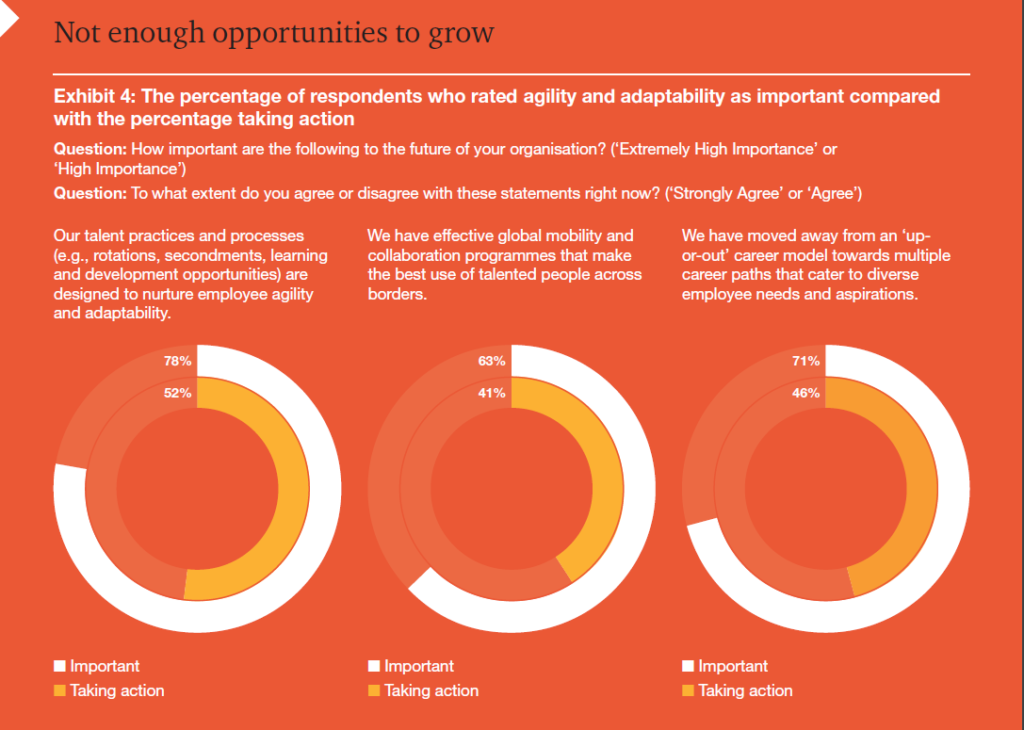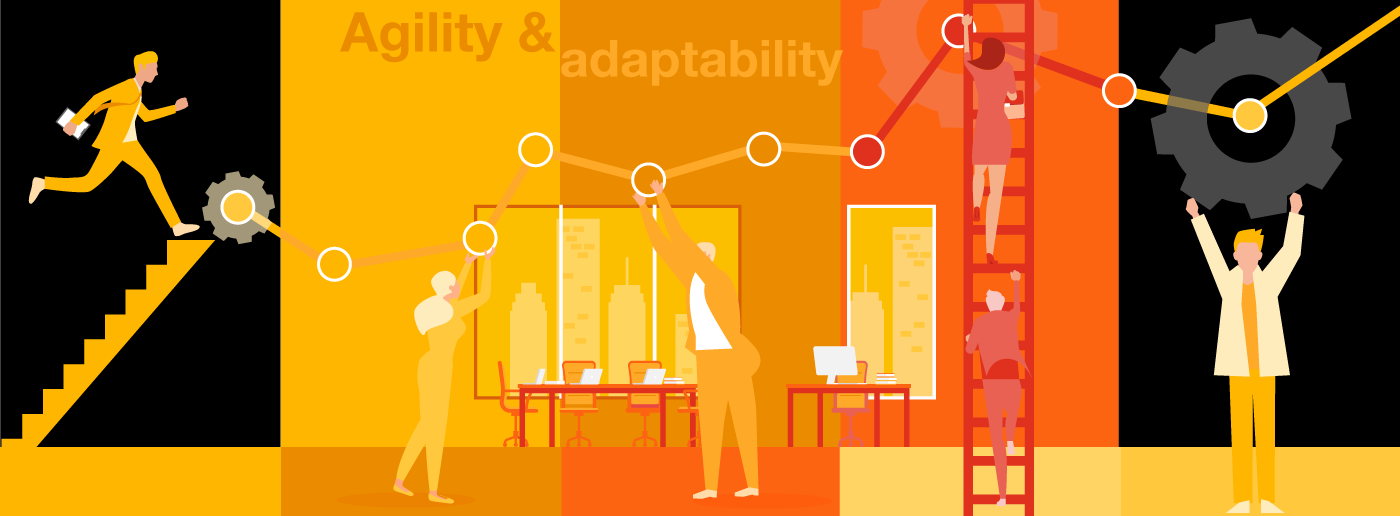Ask yourself right now: “How quickly do I adapt?” Next, ask yourself: “How quickly do I change?”
Now, tell me the answers and right away I will be able to tell you the likelihood that you will succeed. Because how fast you are able to change and how quickly you can adapt are the keys to the kingdom.
But wait, you ask, aren’t change and adaptation the same thing? In fact, no they are not. When changing, we become something different, when adapting, we arrange our circumstances to make them fit for certain new realities.
You can argue the point, but in the end semantics won’t help anyone become the exception. Today, the increase of life expectancy and the emerging skill sets that technological advancements demand translate into pressure for individuals and businesses to line up with whatever change or adaptation strategy they want to bet on.
“Instability is the new stability”. The first step to embracing that motto is to develop a positive attitude towards change. Is there any other option, after all? We are all playing the changing game, a sort of egalitarian exercise imposed on each individual, on every single business, and on society in general. In Orwell’s 1984, he thought totalitarianism would be exerted by “Big Brother”; but he likely did not imagine that we would help create it.
If businesses play a role in the changing game, it makes sense to teach their employees how to play as well and encourage them so that a team is formed and the chances to succeed expand. For instance, emphasising the importance of diversity of experiences and encouraging lifelong learning are two of several tactics to put in place for a future win.
Employees themselves increasingly push for continuous learning and development opportunities and companies need to listen and deliver quality training tailored to individual needs. Businesses cannot merely rely on education institutions to feed the need in an ever shifting landscape of changing jobs and skills requirements.
For companies hiring younger employees, the ability to learn and progress is now a key employment criteria and an important factor in their own brand building. The old business saying used to be, “It isn’t what you know, but who you know.” Perhaps we can update that to, “It’s isn’t what you know OR who you know, but how quickly you can learn something new.”
In our previous People Experience series, we shared with you tips on how to burn the burnout down, the importance of redesigning loneliness at the workplace for a mentally-wealthy and more productive workforce, and how to build the autonomy equation into business.
In this article, we dive into yet another dimension: agility and adaptability in the workplace or, to be more precise, the importance of employees viewing change as something constant and as an opportunity to further develop their careers. And we might add, change is a constant with no end, meaning as you lose the ability to change and adapt, you will get stuck.
Recognise that change is constant
Employees will need to train and retrain throughout their lives just as businesses will need to adapt and transform again and again. Maybe, it’ll be triggered by market needs, client demands, the development and implementation of technology, or even personal and professional goals.
For a business to adapt or change rapidly, its most valuable asset, its people, must adopt a positive attitude towards unceasing change. This might seem contradictory: ultimately, the main constant in that equation is the inconstant.
But, is a “positive attitude towards change” something that can be actually taught or encouraged? We need to be clear about this. It isn’t as easy as taking an online course, or attending a masterclass. If change isn’t entrenched in the business culture, no course in the world can teach people how to be almost permanently prepared to do things differently tomorrow.
And structural and operational changes come right after establishing a culture of change.
Businesses, then, need to do more than just provide training.
Like death and taxes, you can count on change from here on in. Change is set to be continual, demanding and often fast-paced. At times it is, and will be, hard to manage, especially when it feels like there is no Plan B. But, what if a business and its people see change as what they need, even if it’s hard to see it that way in the beginning? If you want to win the game, you have to change, and probably change often.
By helping employees gain this understanding, businesses learn too.
We think that, when embedding a change mindset powered by transparency, agility and the encouragement of feedback and constructive critique, employees themselves can recognise the skills they’ll need at short and medium term.
However, understanding the importance of forging a culture of change, doesn’t necessarily translate into taking enough action to support employees when navigating the rough waters of change.

Provide ‘just-enough, just-in-time and just-for-me’ learning
Even if businesses need to do more than just provide training, any training initiative they conceive needs to be adapted to current employees’ ways of consuming information and learning.
Classroom teaching and incremental development of skill sets are at odds with the new world of work. People are now accustomed to getting information in real time, in short sprints, through online platforms.
Within companies, this transformation is also shifting from ‘just-in-case’ learning, typical of university programmes, to an approach described as ‘just-enough, just-in-time and just-for-me’. The emphasis is on personalised, concise and accessible content across devices when and wherever it’s wanted.
From learning provider to learning enabler, businesses want employees to own their learning.
By empowering people to define their skills gap and choose when, how and what they want to learn, employees can perceive change as a positive driver that keeps them up-to-date and relevant.
For these new ways of learning to work, however, the relationship between employer and employees needs to change and adapt too.
Mobilise the troops… internally
Diverse experiences and skill sets will be critical for people if they are to successfully transform themselves many times over their working life.
For instance, a business can help people gain skills by providing opportunities for them to try a new role in a different department or even in a different country. Job rotations and secondments broaden an employee’s skill set, making them more resilient to future change.
Job rotations also create agility within the business, making it easier for people to move out of roles that are no longer required and into new value-adding positions. But this isn’t just for the people. Businesses benefit from bringing diverse perspectives together to address specific challenges and it helps eliminate the kind of territorial thinking of old – where one person stays in one area in a company and guards it like their fiefdom thereby killing innovative thinking and fresh blood.
An internal mobility strategy enables companies to combine several practices and skill sets to rethink old products, create new services and developing new ways of working.
Offer career customisation
The traditional model of education, employment and retirement has underpinned organisations’ processes and practices for generations. This three-stage model gives a clear direction of the career path. As a result, career success is measured through the rate of upward mobility and tangible assets, such as salary.
But diversity has many faces and what we are witnessing now is a rise in the variety of employees from several generations. And employees, who are growing more and more used to change, and often seeking this valuable mix. People of every age have different motivational factors. At varying times some people want to build a career that blends corporate jobs, freelance gigs and time spent out of the workforce to rethink their skills, dedicate time to education, or simply to take a break from work life.
Such ‘multi-directionality’ doesn’t just affect career paths; it has implications for the evaluation of career success. Employees now have multiple options. For example, instead of racing up the corporate ladder, people are often willing to make a lateral move into a position with a similar pay grade to gain greater personal satisfaction or to pursue an entirely new career path.
Employees first look to see if there is an opportunity at their current company before looking elsewhere. Why? Because, if given a choice, employees will first attempt to remain with their current employer, but only if they have the opportunity to customise their careers.
Businesses may, however, assume they know their employees’ motivations based on their gender, age or life stage. This would be like taking a shot in the dark. Businesses need to empower employees to set their own goals and expectations in terms of the speed and direction of career progression.
Businesses might also want to consider endorsing practices such as ongoing networking, training and mentoring to reintegrate employees who may decide to leave or to dial down responsibility at various points in their career course.
Only 37% of business leaders agreed or strongly agreed that their organisations offer career customisation, compared to 52% of HR leaders. This means that broad communication of such initiatives and role modelling by senior leadership is of paramount importance.
Are change and adaptation the same thing?
We know they aren’t. Change is inevitable, but it’s our choice to reject or accept it. Fear of the unknown, an expectation of loss and how people perceive change is what creates resistance.
It will equally affect us all, or disrupt us, whatever verb you fancy. No hierarchies neither business size or a particular type of job can scape it. It’s, somehow a democratising force.
Changing isn’t easy. We like “the established ways”. They are predictable, and predictability brings the sense of security humans search naturally.
What it’s interesting, though, is how humans got here until now. We’ve periodically changed to be secured and more comfortable. We’ve dared to go further every single time trading security for newness, wealth and pleasure.
Change is part of our nature. What we need to add now is the speed variable. Yes, it’s all about the speed.

